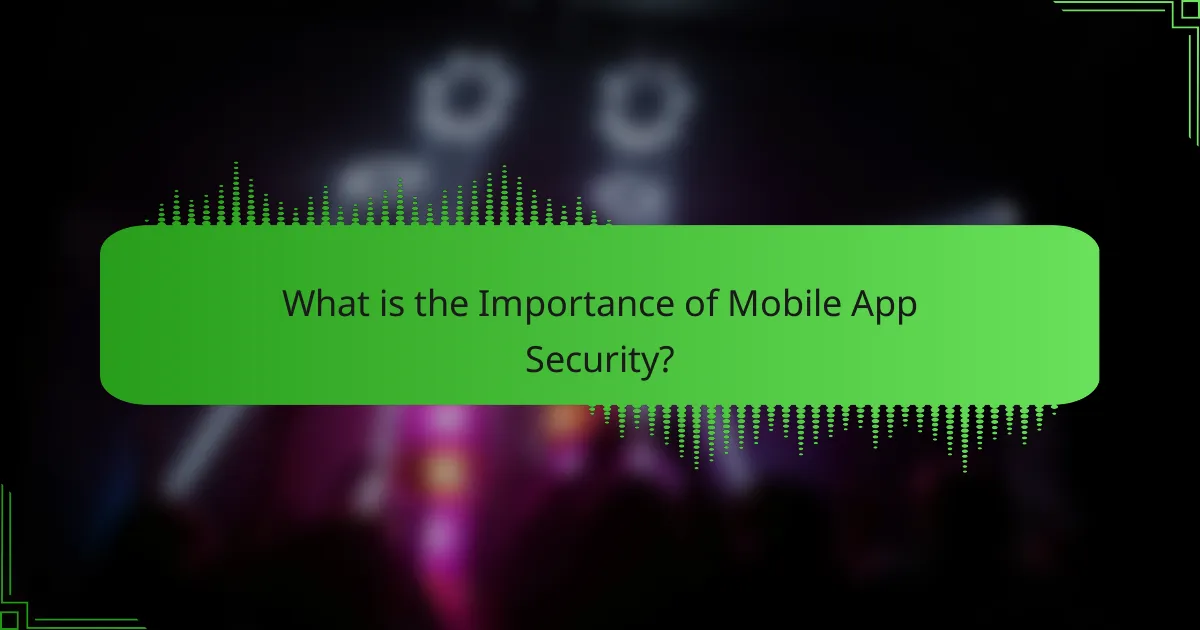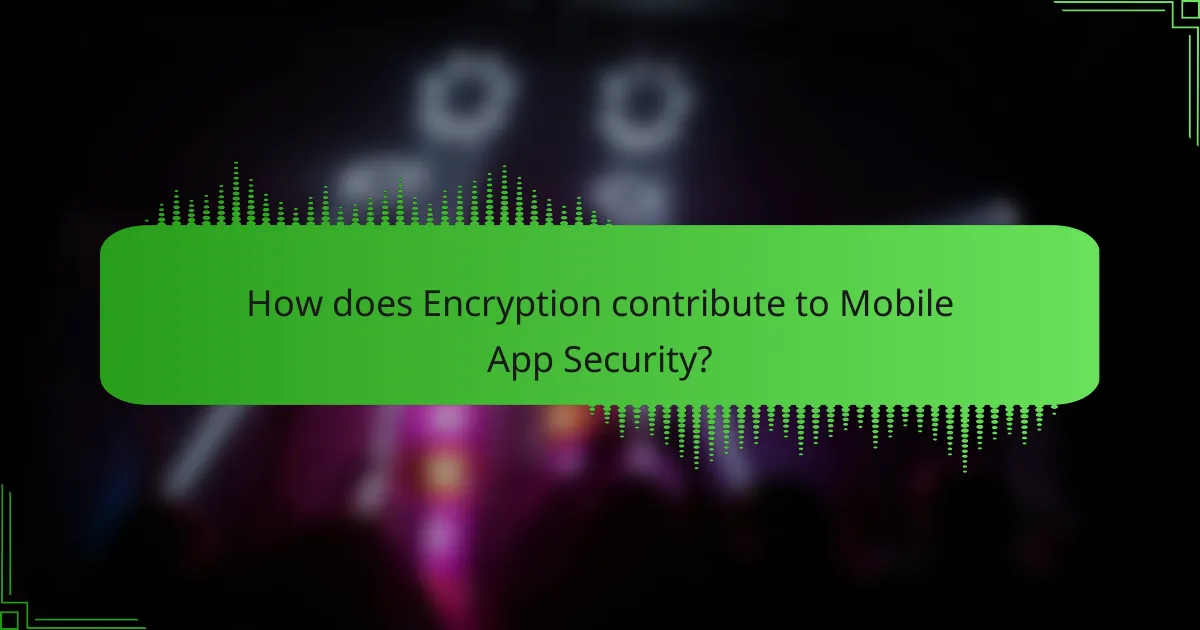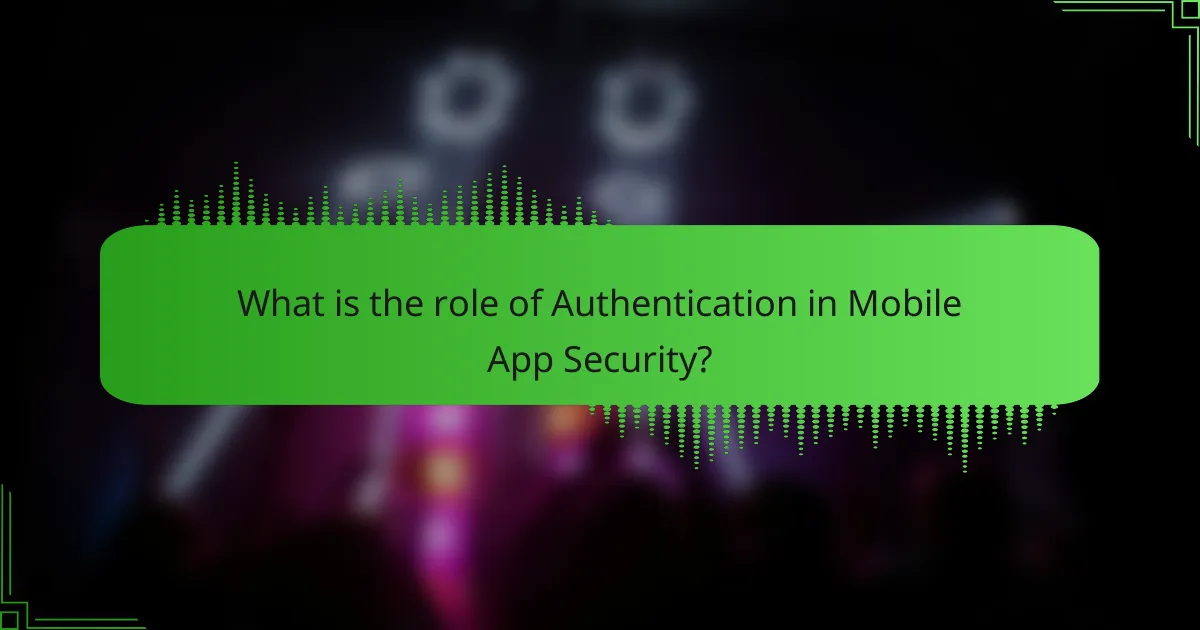Mobile app security is essential for safeguarding sensitive user data and maintaining user trust. Key components of mobile app security include encryption and authentication, which protect against unauthorized access, data breaches, and cyber threats. In 2022, a staggering 93% of mobile apps exhibited vulnerabilities, underscoring the urgent need for robust security measures. Encryption secures data both in transit and at rest, while strong authentication methods, such as multi-factor authentication, ensure that only authorized users can access applications. Prioritizing these security practices is crucial for protecting user information, minimizing financial loss, and ensuring compliance with regulations.

What is the Importance of Mobile App Security?
Mobile app security is crucial for protecting sensitive user data and maintaining user trust. It safeguards against unauthorized access, data breaches, and cyber threats. In 2022, 93% of mobile apps had vulnerabilities, highlighting the need for robust security measures. Effective mobile app security includes encryption, which secures data in transit and at rest. Authentication processes ensure that only authorized users can access the app. Additionally, implementing security best practices reduces the risk of financial loss and reputational damage for businesses. Overall, prioritizing mobile app security is essential for user safety and compliance with regulations.
Why is mobile app security crucial in today’s digital landscape?
Mobile app security is crucial in today’s digital landscape to protect sensitive user data and prevent unauthorized access. With over 3.5 billion smartphone users globally, mobile applications are prime targets for cyberattacks. According to a 2021 report by Check Point Software Technologies, mobile malware attacks increased by 50% compared to the previous year. Additionally, 85% of mobile apps have vulnerabilities that can be exploited by attackers, as noted by the 2022 State of Mobile Application Security report by Veracode. Proper security measures, such as encryption and authentication, are essential to safeguard personal information and maintain user trust.
What risks do mobile apps face without proper security measures?
Mobile apps without proper security measures face multiple risks. These include data breaches, which can expose sensitive user information. Without encryption, data transmitted over networks is vulnerable to interception. Weak authentication processes allow unauthorized access to user accounts. Malicious attacks, such as malware or phishing, can compromise app integrity. Additionally, poor security can lead to financial loss for both users and developers. According to a 2021 report by IBM, the average cost of a data breach is $4.24 million. Consequently, inadequate security measures create significant financial and reputational risks for mobile app developers.
How do security breaches impact users and businesses?
Security breaches negatively impact both users and businesses. Users may experience identity theft, financial loss, and privacy violations. Businesses face reputational damage, legal consequences, and financial costs related to recovery. According to a 2020 IBM report, the average cost of a data breach is $3.86 million. Additionally, 60% of small businesses close within six months of a cyber attack. These statistics demonstrate the severe implications of security breaches for all parties involved.
What are the key components of mobile app security?
The key components of mobile app security include encryption, authentication, and data protection. Encryption safeguards user data by converting it into an unreadable format. This process ensures that even if data is intercepted, it remains secure. Authentication verifies the identity of users accessing the app. Multi-factor authentication enhances this security by requiring additional verification steps. Data protection involves securing sensitive information stored on devices and during transmission. This can include using secure coding practices and regular security updates. These components work together to create a robust security framework for mobile applications.
What role does encryption play in mobile app security?
Encryption is essential for mobile app security as it protects sensitive data from unauthorized access. It converts data into a coded format that can only be read by authorized users with the correct decryption key. This process safeguards personal information, such as passwords and credit card details, during transmission and storage. Research indicates that 80% of data breaches involve unencrypted data. By implementing encryption, mobile apps can significantly reduce the risk of data theft and enhance user trust. Additionally, encryption complies with legal standards, such as GDPR and HIPAA, which mandate data protection measures.
How does authentication enhance mobile app security?
Authentication enhances mobile app security by verifying user identities before granting access. This process prevents unauthorized users from accessing sensitive data. Strong authentication methods, such as multi-factor authentication, add an extra layer of protection. According to a study by Verizon, 81% of data breaches are due to weak or stolen passwords. Implementing robust authentication reduces this risk significantly. Secure authentication mechanisms also help maintain user trust in the app. Overall, authentication is a critical component of a comprehensive mobile app security strategy.
What methods are used for data protection in mobile apps?
Data protection in mobile apps is achieved through several methods. Encryption is a primary method, converting data into a secure format that only authorized users can access. Secure APIs are also utilized to protect data during transmission between the app and servers. Authentication methods, such as two-factor authentication, ensure that only verified users can access sensitive information. Data masking hides sensitive data elements to prevent unauthorized access. Regular security updates and patches help address vulnerabilities in the app. Additionally, secure storage mechanisms, like keychain services, protect sensitive data on the device. These methods collectively enhance the security posture of mobile applications.

How does Encryption contribute to Mobile App Security?
Encryption enhances mobile app security by safeguarding sensitive data from unauthorized access. It converts readable information into an unreadable format, ensuring that only authorized users can decrypt and access the data. This process protects user credentials, personal information, and financial details stored within mobile applications.
Research indicates that 81% of data breaches involve weak or stolen passwords, emphasizing the need for encryption. By implementing encryption protocols, such as AES (Advanced Encryption Standard), mobile apps can significantly reduce the risk of data theft. Furthermore, encryption ensures data integrity, preventing unauthorized alterations during transmission.
According to a study by the Ponemon Institute, organizations that utilize encryption experience 30% fewer data breaches. This statistic highlights the effectiveness of encryption in enhancing mobile app security. Overall, encryption is a critical component in protecting user data and maintaining trust in mobile applications.
What types of encryption are commonly used in mobile apps?
Common types of encryption used in mobile apps include symmetric encryption, asymmetric encryption, and hashing. Symmetric encryption uses the same key for both encryption and decryption, making it fast and efficient. AES (Advanced Encryption Standard) is a widely used symmetric encryption algorithm. Asymmetric encryption employs a pair of keys, a public key for encryption and a private key for decryption. RSA (Rivest-Shamir-Adleman) is a common asymmetric encryption method. Hashing transforms data into a fixed-size string, ensuring data integrity. SHA-256 (Secure Hash Algorithm 256-bit) is a popular hashing algorithm. These encryption methods enhance mobile app security by protecting user data and ensuring secure communication.
How does symmetric encryption differ from asymmetric encryption?
Symmetric encryption uses the same key for both encryption and decryption. In contrast, asymmetric encryption employs a pair of keys: a public key for encryption and a private key for decryption. Symmetric encryption is generally faster and requires less computational power. Asymmetric encryption, while more secure for key exchange, is slower due to complex mathematical operations. Symmetric encryption is suitable for encrypting large amounts of data efficiently. Asymmetric encryption is often used for secure key exchange and digital signatures. The National Institute of Standards and Technology (NIST) has established guidelines that differentiate these encryption methods based on their applications and security needs.
What are the benefits of using end-to-end encryption?
End-to-end encryption ensures that only the communicating users can read the messages. This method protects data from unauthorized access during transmission. It prevents interception by third parties, including service providers. End-to-end encryption enhances user privacy and confidentiality. According to a report by the Electronic Frontier Foundation, it significantly reduces the risk of data breaches. Additionally, it fosters trust between users and service providers. By safeguarding sensitive information, it complies with data protection regulations like GDPR. Overall, end-to-end encryption is crucial for maintaining secure communications in mobile apps.
How effective is encryption in protecting sensitive data?
Encryption is highly effective in protecting sensitive data. It transforms data into an unreadable format for unauthorized users. Only those with the correct decryption key can access the original information. A study by the Ponemon Institute found that 80% of organizations that implemented encryption experienced reduced data breaches. Additionally, encryption helps meet compliance requirements such as GDPR and HIPAA. This adds a layer of legal protection for organizations handling sensitive information. Overall, encryption significantly enhances data security by safeguarding against unauthorized access and breaches.
What are the limitations of encryption in mobile app security?
Encryption in mobile app security has several limitations. First, encryption does not protect data when it is in use. Attackers can exploit vulnerabilities in applications to access unencrypted data during processing. Second, encryption relies on key management. Poor key management can lead to unauthorized access. Third, encryption can introduce performance overhead. This can affect app responsiveness and user experience. Fourth, encryption is not a complete security solution. It must be combined with other measures like authentication and secure coding practices. Finally, encryption can be susceptible to side-channel attacks. These attacks exploit information leaked during encryption processes.
How can developers implement encryption effectively?
Developers can implement encryption effectively by utilizing established cryptographic algorithms and libraries. They should choose strong encryption standards, such as AES (Advanced Encryption Standard) with a key size of at least 256 bits. Implementing encryption at both data-at-rest and data-in-transit is crucial. This ensures that sensitive information is protected while stored and during transmission.
Using secure key management practices is essential. Developers should avoid hardcoding encryption keys within the application code. Instead, they can use secure storage solutions, such as hardware security modules (HSM) or key management services (KMS). Regularly updating encryption methods and libraries is also important to mitigate vulnerabilities.
Additionally, developers should conduct thorough testing to identify potential weaknesses in their encryption implementation. Following industry standards and guidelines, such as those provided by NIST (National Institute of Standards and Technology), can further enhance the effectiveness of encryption.

What is the role of Authentication in Mobile App Security?
Authentication is a critical component of mobile app security. It verifies the identity of users attempting to access the application. This process helps prevent unauthorized access to sensitive data and functionalities. Strong authentication methods, such as multi-factor authentication, enhance security further. According to a 2020 study by Verizon, 80% of data breaches involve compromised credentials. This statistic underscores the importance of robust authentication measures. By ensuring that only legitimate users can access the app, authentication protects user data and maintains trust. Effective authentication processes also aid in compliance with data protection regulations.
What are the different authentication methods used in mobile apps?
The different authentication methods used in mobile apps include password-based authentication, biometric authentication, two-factor authentication, and single sign-on. Password-based authentication requires users to enter a username and password. This method is common but can be vulnerable to breaches. Biometric authentication uses unique physical traits, such as fingerprints or [censured] recognition, to verify identity. This method enhances security due to the uniqueness of biometric data. Two-factor authentication adds an extra layer of security by requiring a second form of verification, like a text message code. Single sign-on allows users to access multiple applications with one set of credentials, improving user experience while maintaining security. Each method has its advantages and challenges, impacting overall mobile app security.
How does multi-factor authentication enhance security?
Multi-factor authentication enhances security by requiring multiple forms of verification before granting access. This process adds an additional layer of protection beyond just a password. Users must provide something they know, such as a password, and something they have, like a smartphone app or hardware token. This makes unauthorized access significantly more difficult. According to a study by the Cybersecurity & Infrastructure Security Agency, multi-factor authentication can block over 99% of automated cyberattacks. The combination of different authentication factors reduces the risk of credential theft. Multi-factor authentication also alerts users to suspicious login attempts, enhancing overall security awareness.
What are the advantages of biometric authentication?
Biometric authentication offers several advantages over traditional methods. It provides enhanced security by using unique biological traits such as fingerprints or [censured] recognition. These traits are difficult to replicate or forge, making unauthorized access more challenging.
Biometric systems also offer convenience. Users do not need to remember passwords or carry physical tokens. Instead, they can authenticate quickly and easily using their biometric data.
Additionally, biometric authentication can improve user experience. It streamlines the login process, reducing friction during access. According to a study by the National Institute of Standards and Technology, biometric methods can significantly decrease authentication time compared to passwords.
Furthermore, biometric authentication can reduce the risk of identity theft. Since biometric data is unique to each individual, it is less likely to be compromised compared to traditional passwords. Overall, these advantages make biometric authentication a compelling choice for enhancing mobile app security.
How does proper authentication prevent unauthorized access?
Proper authentication prevents unauthorized access by verifying the identity of users before granting access to systems. It requires users to provide credentials, such as passwords or biometric data. This process ensures that only authorized individuals can access sensitive information or functionalities. Strong authentication methods, like two-factor authentication, add an extra layer of security. They require a second form of verification, making it harder for unauthorized users to gain access. According to a study by Verizon, 81% of data breaches are due to weak or stolen passwords. This statistic highlights the importance of robust authentication measures in safeguarding data.
What are the common vulnerabilities in authentication processes?
Common vulnerabilities in authentication processes include weak passwords, lack of multi-factor authentication, and session hijacking. Weak passwords are easily guessed or cracked, making accounts susceptible to unauthorized access. A study by Verizon in 2020 found that 80% of data breaches involved weak or stolen credentials. Lack of multi-factor authentication increases risk, as it relies solely on passwords for security. Session hijacking occurs when attackers steal session tokens, allowing them to impersonate legitimate users. Additionally, phishing attacks can trick users into providing their credentials. These vulnerabilities highlight the importance of robust authentication measures in mobile app security.
How can developers strengthen authentication mechanisms?
Developers can strengthen authentication mechanisms by implementing multi-factor authentication (MFA). MFA requires users to provide two or more verification factors to gain access. This significantly reduces the risk of unauthorized access. According to a study by Microsoft, MFA can block 99.9% of account compromise attacks. Developers should also use strong password policies, mandating complex passwords that are regularly updated. Additionally, incorporating biometric authentication methods, such as fingerprint or [censured] recognition, enhances security. Regularly updating and patching authentication systems is crucial to address vulnerabilities. Implementing secure session management practices can prevent session hijacking. Finally, conducting regular security audits helps identify and mitigate potential weaknesses in authentication mechanisms.
What best practices should developers follow for mobile app security?
Developers should follow several best practices for mobile app security. First, they must implement strong encryption methods to protect sensitive data. This includes encrypting data both in transit and at rest. Second, developers should utilize secure authentication mechanisms. Multi-factor authentication significantly enhances security. Third, they need to validate all inputs to prevent injection attacks. Proper input validation can mitigate risks associated with malicious data. Fourth, developers should regularly update their apps to patch vulnerabilities. Keeping software up to date reduces the chances of exploitation. Fifth, they must employ secure coding practices. This includes avoiding hardcoded credentials and using secure APIs. Finally, developers should conduct thorough security testing, including [censured] testing and code reviews. Regular testing helps identify and address potential security flaws. Following these practices can greatly improve the security posture of mobile applications.
How can users protect their data while using mobile apps?
Users can protect their data while using mobile apps by following several key practices. First, they should enable two-factor authentication whenever available. This adds an extra layer of security beyond just a password. Second, users must regularly update their apps to the latest versions. Updates often include security patches that fix vulnerabilities. Third, they should only download apps from trusted sources, such as official app stores. Research shows that apps from unofficial sources are more likely to contain malware. Fourth, users should review app permissions carefully. Limiting access to only necessary data can minimize exposure. Additionally, employing a VPN when using public Wi-Fi can protect data from interception. Lastly, users should consider using strong, unique passwords for each app. This reduces the risk of unauthorized access.
The main entity of the article is mobile app security, which encompasses essential aspects such as encryption, authentication, and data protection. The article highlights the critical importance of mobile app security in safeguarding sensitive user data and preventing unauthorized access, particularly in a landscape where mobile applications are frequent targets for cyberattacks. It discusses the risks associated with inadequate security measures, the impact of security breaches on users and businesses, and outlines key components for effective security, including various encryption and authentication methods. Additionally, best practices for developers and users are provided to enhance mobile app security and protect personal information.


